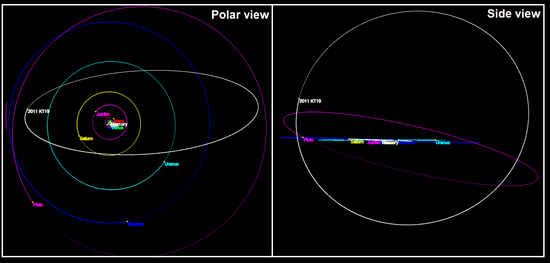|
(471325) 2011 KT19
(471325) 2011 KT19, nicknamed Niku (/niːkuː/), is a trans-Neptunian object whose orbit is tilted 110° with respect to the planets' orbital plane. Thus, it has a nearly polar retrograde orbit around the Sun.[2][7][8][9] While the object has not received a formal name, it received the moniker "Niku" (逆骨), meaning "rebellious" in the Chinese language, by its discoverers.[10][11] Details(471325) 2011 KT19 was discovered by the Mount Lemmon Survey on 31 May 2011. Its rediscovery was announced in August 2016 by a team of astronomers using the Pan-STARRS telescope. It was soon linked with a supposed prograde centaur (2011 KT19; inclination = 38° and semi-major axis = 28 AU) that had been lost due to a short observation arc.[1][7] 2011 KT19 is in a 7:9 resonance with Neptune. Currently it is the only object with a nearly polar orbit that is in resonance with a planet.[12] Notably, it is part of a group of objects that orbit the Sun in a highly inclined orbit; the reasons for this unusual orbit are unknown as of August 2016.[13] The orbital characteristics of 2011 KT19 have been compared to those of 2008 KV42 (Drac). The orbits of 2011 KT19, 2008 KV42, 2002 XU93, 2010 WG9, 2007 BP102, 2011 MM4, appear to occupy a common plane, with three in prograde and three in retrograde orbits. The probability of this alignment occurring by chance is 0.016%. These orbits should leave a common plane in a few million years because the precession of prograde and retrograde orbits are in opposite directions. Simulations including the hypothetical Planet Nine did not maintain a common orbital plane and the plane does not coincide with the plane of the predicted high-inclination large semi-major axis objects of that model. Other simulations with a few Earth-mass dwarf planet on a high-inclination orbit also failed to reproduce the alignment.[7] Based on an albedo of 0.045, 2011 KT19 measures about 225 km in diameter, roughly the size of Saturn's moon Phoebe and the sednoid 541132 Leleākūhonua. Michael E. Brown measures a diameter of 163 km. It is the largest retrograde planetoid in the Solar System. Light-curve analysis from 2016 showed only small deviations, which suggested that 2011 KT19 is a spheroid about 250 km with small albedo spots and hence a dwarf planet. It is not included in Michael E. Brown's number of dwarf planet candidates from now because, having an assumed albedo of 0.08 and an absolute magnitude of 7.4, it would be less than the 200 km cutoff the astronomer said on the same website.
References
External links |
||||||||||||||||||||||||||||||||||||||||||||||||||||||||||||




